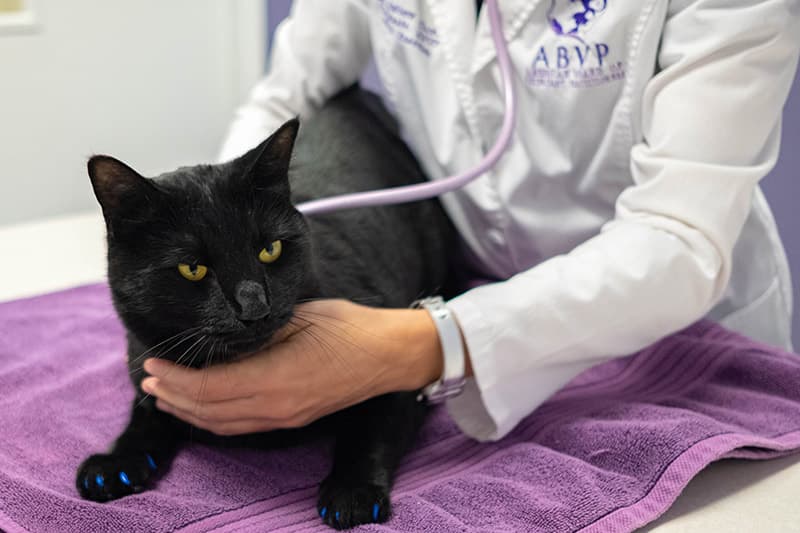Preparing Your Cat For A Hurricane
It’s a Monday morning at my feline-only veterinary hospital and the phones are ringing.
“Can I board my cat in case I need to evacuate?”
“Can I pick up stress-relieving medication in an hour from now?”
“Do you have my cat’s special food in stock?”
“Can I update my cat’s Rabies vaccines today at 4:00 in case we need to go to a shelter?”
It’s “Fall” in Florida, aka Hurricane Season. There’s something brewing way out in the ocean and we can feel a different energy in the air.
Did you know that preparing your cat for a hurricane involves more than just grabbing a carrier and some extra food?
Whether you live in a hurricane-prone area like I do or just want to be prepared for the unexpected, understanding how to protect your cat is a big deal. Even thunderstorms can be scary for some cats, so these same tips apply.
Don’t wait until it’s too late – start preparing today!
As an Amazon Associate I earn from qualifying purchases.
Preparing Your Cat For A Hurricane: Creating a cozy and safe space

While assembling an emergency kit is undoubtedly important, it’s also crucial to create a safe space for your cat during a hurricane. Just like humans, cats seek comfort and security during times of stress, and providing them with a designated area can help alleviate their anxiety.
Here are some tips to help you establish a safe zone where your cat can feel calm and protected.
First and foremost, choose a quiet room in your home where your cat can retreat to when the storm hits. Ideally, this space should be a windowless room, such as a bathroom or a walk-in closet, to minimize the sound of wind and rain.
If you don’t have a suitable windowless room, you can cover the windows with thick curtains or use cardboard to block out the storm’s visual and auditory stimuli.
Next, make sure the room is adequately stocked with all the necessities your cat may need. Place her carrier in the room, along with food and water bowls, a litter box, and a comfortable bed or blanket. It’s essential to place these items away from windows or doors to prevent any potential accidents or escape attempts during the chaos of the storm. Hiding huts are awesome places for cats to feel safe! Check out my Cattasaurus post for my cats’ favorite getaway spot.
To create a sense of familiarity and security, add some of your cat’s favorite toys or blankets to the room. Familiar scents and objects can provide a calming effect, as they remind your cat of their usual safe and cozy environment.

Additionally, consider using a plug-in pheromone diffuser such as Feliway, which releases synthetic calming pheromones designed to help reduce stress and anxiety in cats.
Pro Tip: Use these diffusers year-round in your home. I have 3 of them throughout my house.
As the storm approaches, prepare the room for your cat’s extended stay by blocking off any potential hiding spots or dangerous areas. Cover gaps behind furniture or appliances, secure shelves and cabinets, and remove any small items that could be swallowed or cause harm.
By creating a controlled and safe environment, you can minimize potential hazards for your cat and provide peace of mind for yourself.
Additionally, your stress level will feed your cat’s stress level. I see it every day during exams. Owners who are high-stress and saying over and over “It’s ok, it’s ok, it’s ok” in a rushed voice only seem to make the situation worse.
Stay calm and let your cat sense your energy!
Preparing Your Cat For A Hurricane: Assembling an emergency kit

You’ve got to have that emergency kit tailored specifically to your cat. Again, don’t wait. Get ready ahead of time!
- Start by including enough food and water for your cat to last at least five days. Pack dry or canned food that has a long shelf life, as well as a manual can opener if needed.
- Include a recent photo of you and your cat in case you were to get separated.
- Don’t forget to include a few of her favorite treats to provide some familiarity and comfort during the stressful period. Additionally, ensure you have enough fresh water stored in labeled containers and rotate these supplies periodically to keep them fresh.
- In your emergency kit, also include necessary medications and medical records. It’s essential to have a supply of any prescription medications your cat needs, as well as any regular flea or heartworm medications that they may be due for.
- Contact your vet a week ahead of time to request any anti-anxiety or calming medications you might need, not only for the storm itself but also for travel in case you need to evacuate.
- Keep a copy of her medical records and vaccination history in a waterproof bag or folder, ensuring you have easy access to important information in case of evacuation or a visit to an unfamiliar vet.
- Include a blanket or towel with your cat’s scent on it. This will provide a sense of security and comfort for your cat in an unfamiliar environment.
- Additionally, pack a sturdy carrier or crate for transportation purposes, as well as a litter box, litter, and disposable bags for waste removal. Don’t forget to pack a small scoop as well for easy clean-up. Remember, you don’t have to bring the world’s best litter box. It’s an emergency. Something lightweight and portable will do!
Lastly, don’t forget to include a few small toys and interactive items to keep your cat mentally stimulated during the storm. Pack her favorite toys, scratching posts, or puzzle feeders IF easily transportable to help alleviate potential boredom and anxiety. My cats love these lifelike flapping birds! In fact, Bacon got so excited he fell off the counter with the bird in his mouth!
Preparing Your Cat For A Hurricane: Understanding your cat’s behavior

In times of stress or anxiety, cats often seek out familiar spaces where they feel safe and secure. As you set up your cat’s designated area in your home, take note of where she typically retreats to when feeling calm. Whether it’s a cozy corner, under a bed, or in a specific room, try to recreate a similar environment in your emergency setup. This will provide her with a sense of familiarity and comfort during the storm.
Cats are creatures of routine, and any disruption to their usual schedule can cause anxiety. As you prepare for the hurricane, try to maintain a semblance of your cat’s daily routine as much as possible. Stick to her regular feeding and playtime schedule to help minimize any additional stress she may be experiencing.
Cats are sensitive little creatures! They are not fans of changes in their environment and can pick up on your own stress and emotions. Your cat may become more clingy or seek additional attention during the storm, as they look to you for reassurance.
In some cases, cats may exhibit behavior changes such as increased vocalization, hiding, or even aggression during a hurricane. These behaviors are often their way of expressing fear or anxiety.
Keep in mind that these reactions are normal responses to a high-stress situation. By recognizing these behaviors as signs of distress, you can respond with patience and a calm demeanor, further helping to alleviate their anxiety.
Preparing Your Cat For A Hurricane: Getting ready for evacuation

Ugh, something no one wants to do, but sometimes it’s a necessity. I’ve been there myself. My husband, toddler and 3 cats evacuated to Alabama one year.
You always need to plan for the possibility of evacuation. Disasters can be unpredictable, and it’s always better to err on the side of caution. If it’s not safe for you to stay, it’s not safe for your cat either.
First and foremost, keep your emergency kit ready at all times. The cat carrier is key and needs to be a sturdy one that will not bust open.
Next, familiarize yourself with pet-friendly evacuation shelters in your area. Contact local authorities to find out which shelters accept pets and if there are any specific requirements or restrictions.
This is a key reason to keep your cat up-to-date on her vaccines. Many shelters will require proof of current vaccination.
It’s important to note that not all shelters will accommodate animals, so having this information ahead of time will allow you to make alternative arrangements if needed. The same goes for hotels if you are traveling away to evacuate.
Additionally, make sure your cat is wearing identification such as a collar and tag. All cats should be also microchipped as an added layer of protection, as collars can easily come off in stressful situations. Take care of this well ahead of time with your veterinarian.
All my cats are microchipped. I would be a nervous wreck if they weren’t!
Preparing Your Cat For A Hurricane: Post-hurricane safety

The storm may be gone but there can still be dangers.
Keep your cat indoors after a hurricane. Even if your home appears to be safe and secure, there may still be hazards outside. Debris, downed power lines, and other dangerous objects can pose risks. If your cat goes in your fenced backyard like mine do, walk your yard before letting her out.
Get your cat back on her routine as quickly as possible. Whether that’s daily brushing or a treat every morning, this will help her to know that life is getting back to normal.
In conclusion, create a safe space and assemble an emergency kit so that you’re not panicking like everyone else. If you’re calm, cool and collected, your cat will know that!
Have you been through a hurricane with your cats? Mine usually just sleep through it! Let me know in the comments.

















